RSPD: A Novel Remote Sensing Index of Plant Biodiversity Combining Spectral Variation Hypothesis and Productivity Hypothesis
Abstract
:1. Introduction
2. Methods
2.1. Calculating the RSPD
2.2. Evaluating the RSPD
3. Study Materials and Cases
3.1. Study Cases
3.2. Sentinel-2 Data
3.3. Pléiades-1 Data
4. Results
4.1. Spatiotemporal Comparisons between RSPD and CV
4.2. Evaluating RSPD and CV with Classification Results by Sentinel-2 Data
4.3. Evaluating RSPD and CV with Classification Results by Pléiades-1 Data
4.4. Evaluating RSPD with Visual Interpretation of Google Earth Image
5. Discussion
5.1. The Influence of Red-Edge Bands on RSPD
5.2. The Influence of Segment Number on RSPD
5.3. Different Unsupervised Classification Methods on Evaluating RSPD
5.4. Applicability and Prospects of the RSPD
- The RSPD circumvents the drawbacks of the CV. First, the RSPD has a fixed range of values between 0 and 1, which is conducive to dynamically monitoring plant diversity. However, the CV can be less than 1 for low variance distribution, and greater than 1 for high variance distribution. In other words, there is no fixed range for the CV. Besides, the CV value is very susceptible to small changes in the and it would approach infinity when the is close to zero. In contrast, the RSPD can circumvent the limitations of in CV.
- The RSPD is designed to be implemented on a spectral measurement data set synthesized by spectral reflectance and various spectral vegetation indices (e.g., vegetation greenness index, vegetation moisture index, red-edge vegetation index). The spectral vegetation indices can represent the productivity of plant to some extent. The multi-band vegetation reflectance can describe the spectrum feature of plants. Thus, the suggested RSPD combined the productivity hypothesis with the spectral variation hypothesis to monitor the plant diversity.
- Thirdly, the final calculation form of the RSPD referred to the principle of Shannon information entropy. It should be noted that plant diversity should be determined by both species’ richness and evenness. The Shannon information entropy has the ability to integrate the richness and evenness, which is inherent in its calculation formula. The well-known Shannon Diversity index is also based on the principle of Shannon information entropy. Resultantly, the suggested RSPD realized the comprehensive measurement of species richness and evenness.
- Many remote sensing-based methods for mapping plant diversity rely on a field botany survey. That is because they require a large number of field samples to train a mathematical relationship between plant diversity and remote sensing observations. However, conducting a field botany survey is usually costly, and thus has limited application potential. Actually, many areas do not have the economic and technical conditions to carry out field botanical investigation. The suggested RSPD method is a purely remotely sensed index, which means that it can evaluate and monitor the plant diversity independent of field survey. In other words, the RSPD facilitates large-scale and long time series monitoring of plant diversity.
- The proposed RSPD method is not only applicable for Sentinel-2 data. We distinguished that the multiple red-edge bands have a limited promotion effect on the RSPD, implying that the method can also be utilized in other optical satellites such as Landsat and SPOT. It can also be applied with hyperspectral data such as Hyperion, Chris, and the newly launched Zhuhai-1 hyperspectral satellite.
- Firstly, optical remote sensing usually obtains the spectral reflectance from the upper canopy. The understory species are hard to be observed because of the shielding effect. Furtherly, remote sensing has a spatial scale effect, which means that it chiefly reflects the information at the observing scale. With regard to the remote sensing of plant diversity, it can only identify the dominant species at the observing scale. Therefore, we admit that the suggested RSPD and the classical CV methods may not have the capacity to map the diversity of the entire plant community. This study only demonstrates the RSPD’s capacity to map diversity of dominant species. Additionally, due to the existence of mixed pixel, the suggested RSPD and the CV may both be sensitive to habitat heterogeneity. In this study, we have tried our best to mask the non-vegetated pixels. We think this limitation can be reduced with the increasing improvement in spatial resolution of remote sensing technology.
- Secondly, it has been described that while remote sensing indices are closely related to plant diversity, they are also influenced by important factors related to climate, ecosystem type, degree of disturbance, topography, and land cover [39,40]. Therefore, we declare that the suggested RSPD should be implemented in a time scale of a year. The annual RSPD should be the maximum RSPD during a year-long observation, especially the observation during the vegetation growing season. The maximum value composite of RSPD could reduce the effect of seasonal or meteorological variation. On the other hand, due to the expensive cost in conducting field investigating, field survey data were not utilized in this study. However, we believe that the RSPD would work better if it is properly calibrated using field observations, because we have proved that the suggested RSPD is an improvement of the existing CV through the verification with other higher-resolution data.
- The main principle of our model is to reflect plant diversity using spectral variation and productivity hypotheses. If the spectral differences of different vegetation in the ecosystem are very small or the spectra of the same species are significantly different due to environmental factors (i.e., the “different objects with the same spectra” or “same objects with different spectra”), the sensitivity of the model to plant diversity will be reduced. In addition, the sensitivity of the model will also be affected if there is no positive correlation between vegetation productivity and diversity due to the influence of local special conditions. In other words, violations of the assumptions of local conditions or ecosystem characteristics will cause our algorithm to fail. However, compared with the method of only using one hypothesis, our model integrates two hypotheses to reduce the limitations to a certain extent.
6. Conclusions
Author Contributions
Funding
Data Availability Statement
Acknowledgments
Conflicts of Interest
References
- Pullaiah, T.; Bahadur, B.; Krishnamurthy, K.V. Plant Biodiversity. In Plant Biology and Biotechnology; Bahadur, B., Rajam, M.V., Sahijram, L., Krishnamurthy, K., Eds.; Springer: New Delhi, India, 2015; pp. 177–195. [Google Scholar] [CrossRef]
- Wang, R.; Gamon, J.A. Remote sensing of terrestrial plant biodiversity. Remote Sens. Environ. 2019, 231, 111218. [Google Scholar] [CrossRef]
- Barnosky, A.D.; Matzke, N.; Tomiya, S.; Wogan, G.O.U.; Swartz, B.; Quental, T.B.; Marshall, C.; McGuire, J.L.; Lindsey, E.L.; Maguire, K.C.; et al. Has the Earth’s sixth mass extinction already arrived? Nature 2011, 471, 51–57. [Google Scholar] [CrossRef]
- Kerr, J.T.; Ostrovsky, M. From space to species: Ecological applications for remote sensing. Trends Ecol. Evol. 2003, 18, 299–305. [Google Scholar] [CrossRef]
- Lengyel, S.; Kobler, A.; Kutnar, L.; Framstad, E.; Henry, P.Y.; Babij, V.; Gruber, B.; Schmeller, D.; Henle, K. A review and a framework for the integration of biodiversity monitoring at the habitat level. Biodivers. Conserv. 2008, 17, 3341–3356. [Google Scholar] [CrossRef]
- Stoms, D.M.; Estes, J.E. A remote sensing research agenda for mapping and monitoring biodiversity. Int. J. Remote Sens. 1993, 14, 1839–1860. [Google Scholar] [CrossRef]
- Roughgarden, J.; Running, S.W.; Matson, P.A. What does remote sensing do for ecology? Ecology 1991, 72, 1918–1922. [Google Scholar] [CrossRef]
- Broadbent, E.N.; Asner, G.P.; Peña-Claros, M.; Palace, M.; Soriano, M. Spatial partitioning of biomass and diversity in a lowland Bolivian forest: Linking field and remote sensing measurements. For. Ecol. Manag. 2008, 255, 2602–2616. [Google Scholar] [CrossRef]
- Faucon, M.-P.; Houben, D.; Lambers, H. Plant Functional Traits: Soil and Ecosystem Services. Trends Plant Sci. 2017, 22, 385–394. [Google Scholar] [CrossRef]
- Kraft, N.J.B.; Godoy, O.; Levine, J.M. Plant functional traits and the multidimensional nature of species coexistence. Proc. Natl. Acad. Sci. USA 2015, 112, 797–802. [Google Scholar] [CrossRef] [Green Version]
- Stein, A.; Gerstner, K.; Kreft, H. Environmental heterogeneity as a universal driver of species richness across taxa, biomes and spatial scales. Ecol. Lett. 2014, 17, 866–880. [Google Scholar] [CrossRef]
- Brown, J.H. Two Decades of Homage to Santa Rosalia: Toward a General Theory of Diversity. Am. Zool. 1981, 21, 877–888. [Google Scholar] [CrossRef] [Green Version]
- Wright, D.H. Species-energy theory: An extension of species-area theory. Oikos 1983, 41, 496–506. [Google Scholar] [CrossRef] [Green Version]
- Foody, G.M. Mapping the richness and composition of British breeding birds from coarse spatial resolution satellite sensor imagery. Int. J. Remote Sens. 2005, 26, 3943–3956. [Google Scholar] [CrossRef]
- Costanza, J.K.; Moody, A.; Peet, R.K. Multi-scale environmental heterogeneity as a predictor of plant species richness. Landsc. Ecol. 2011, 26, 851–864. [Google Scholar] [CrossRef]
- Hurlbert, A.H.; Haskell, J.P. The effect of energy and seasonality on avian species richness and community composition. Am. Nat. 2003, 161, 83–97. [Google Scholar] [CrossRef]
- Evans, K.L.; James, N.A.; Gaston, K.J. Abundance, species richness and energy availability in the North American avifauna. Glob. Ecol. Biogeogr. 2006, 15, 372–385. [Google Scholar] [CrossRef]
- Leyequien, E.; Verrelst, J.; Slot, M.; Schaepman-Strub, G.; Heitkönig, I.M.; Skidmore, A. Capturing the fugitive: Applying remote sensing to terrestrial animal distribution and diversity. Int. J. Appl. Earth Obs. Geoinf. 2007, 9, 1–20. [Google Scholar] [CrossRef]
- Adams, J.M.; Woodward, F.I. Patterns in tree species richness as a test of the glacial extinction hypothesis. Nature 1989, 339, 699–701. [Google Scholar] [CrossRef]
- Luoto, M.; Kuussaari, M.; Toivonen, T. Modelling butterfly distribution based on remote sensing data. J. Biogeogr. 2002, 29, 1027–1037. [Google Scholar] [CrossRef]
- Rocchini, D.; Balkenhol, N.; Carter, G.A.; Foody, G.M.; Gillespie, T.W.; He, K.S.; Kark, S.; Levin, N.; Lucas, K.; Luoto, M.; et al. Remotely sensed spectral heterogeneity as a proxy of species diversity: Recent advances and open challenges. Ecol. Inform. 2010, 5, 318–329. [Google Scholar] [CrossRef]
- Palmer, M.W.; Earls, P.G.; Hoagland, B.W.; White, P.S.; Wohlgemuth, T. Quantitative tools for perfecting species lists. Environmetrics 2002, 13, 121–137. [Google Scholar] [CrossRef]
- Ustin, S.L.; Gamon, J.A. Remote sensing of plant functional types. New Phytol. 2010, 186, 795–816. [Google Scholar] [CrossRef] [PubMed]
- Gould, W. Remote sensing of vegetation, plant species richness, and regional biodiversity hotspots. Ecol. Appl. 2000, 10, 1861–1870. [Google Scholar] [CrossRef]
- Levin, N.; Shmida, A.; Levanoni, O.; Tamari, H.; Kark, S. Predicting mountain plant richness and rarity from space using satellite-derived vegetation indices. Divers. Distrib. 2007, 13, 692–703. [Google Scholar] [CrossRef]
- Carlson, K.M.; Asner, G.P.; Hughes, R.F.; Ostertag, R.; Martin, R.E. Hyperspectral remote sensing of canopy biodiversity in Hawaiian lowland rainforests. Ecosystems 2007, 10, 536–549. [Google Scholar] [CrossRef]
- Rocchini, D. Effects of spatial and spectral resolution in estimating ecosystem α-diversity by satellite imagery. Remote Sens. Environ. 2007, 111, 423–434. [Google Scholar] [CrossRef]
- Foody, G.M.; Cutler, M.E. Mapping the species richness and composition of tropical forests from remotely sensed data with neural networks. Ecol. Model. 2006, 195, 37–42. [Google Scholar] [CrossRef] [Green Version]
- Gillespie, T.W. Predicting Woody-Plant Species Richness in Tropical Dry Forests: A Case Study from South Florida, USA. Ecol. Appl. 2005, 15, 27–37. [Google Scholar] [CrossRef]
- Rocchini, D.; McGlinn, D.; Ricotta, C.; Neteler, M.; Wohlgemuth, T. Landscape complexity and spatial scale influence the relationship between remotely sensed spectral diversity and survey-based plant species richness. J. Veg. Sci. 2011, 22, 688–698. [Google Scholar] [CrossRef]
- Paz-Kagan, T.; Caras, T.; Herrmann, I.; Shachak, M.; Karnieli, A. Multiscale mapping of species diversity under changed land use using imaging spectroscopy. Ecol. Appl. 2017, 27, 1466–1484. [Google Scholar] [CrossRef]
- Hernández-Stefanoni, J.L.; Gallardo-Cruz, J.A.; Meave, J.A.; Rocchini, D.; Bello-Pineda, J.; López-Martínez, J.O. Modeling α- and β-diversity in a tropical forest from remotely sensed and spatial data. Int. J. Appl. Earth Obs. Geoinf. 2012, 19, 359–368. [Google Scholar] [CrossRef]
- Nagendra, H.; Rocchini, D.; Ghate, R.; Sharma, B.; Pareeth, S. Assessing Plant Diversity in a Dry Tropical Forest: Comparing the Utility of Landsat and Ikonos Satellite Images. Remote Sens. 2010, 2, 478–496. [Google Scholar] [CrossRef] [Green Version]
- Fava, F.; Parolo, G.; Colombo, R.; Gusmeroli, F.; Della Marianna, G.; Monteiro, A.T.; Bocchi, S. Fine-scale assessment of hay meadow productivity and plant diversity in the European Alps using field spectrometric data. Agric. Ecosyst. Environ. 2010, 137, 151–157. [Google Scholar] [CrossRef]
- Ma, X.; Mahecha, M.D.; Migliavacca, M.; van der Plas, F.; Benavides, R.; Ratcliffe, S.; Kattge, J.; Richter, R.; Musavi, T.; Baeten, L.; et al. Inferring plant functional diversity from space: The potential of Sentinel-2. Remote Sens. Environ. 2019, 233, 111368. [Google Scholar] [CrossRef]
- Fauvel, M.; Lopes, M.; Dubo, T.; Rivers-Moore, J.; Frison, P.-L.; Gross, N.; Ouin, A. Prediction of plant diversity in grasslands using Sentinel-1 and -2 satellite image time series. Remote Sens. Environ. 2020, 237, 111536. [Google Scholar] [CrossRef]
- Wang, R.; Gamon, J.A.; Emmerton, C.A.; Li, H.T.; Nestola, E.; Pastorello, G.Z.; Menzer, O. Integrated Analysis of Productivity and Biodiversity in a Southern Alberta Prairie. Remote Sens. 2016, 8, 214. [Google Scholar] [CrossRef] [Green Version]
- Sun, H.; Chen, Y.H.; Zhan, W.F. Comparing surface- and canopy-layer urban heat islands over Beijing using MODIS data. Int. J. Remote Sens. 2015, 36, 5448–5465. [Google Scholar] [CrossRef]
- Oehri, J.; Schmid, B.; Schaepman-Strub, G.; Niklaus, P.A. Biodiversity promotes primary productivity and growing season lengthening at the landscape scale. Proc. Natl. Acad. Sci. USA 2017, 114, 10160–10165. [Google Scholar] [CrossRef] [Green Version]
- Wang, R.; Gamon, J.A.; Montgomery, R.A.; Townsend, P.A.; Zygielbaum, A.I.; Bitan, K.; Tilman, D.; Cavender-Bares, J. Seasonal Variation in the NDVI-Species Richness Relationship in a Prairie Grassland Experiment (Cedar Creek). Remote Sens. 2016, 8, 128. [Google Scholar] [CrossRef] [Green Version]
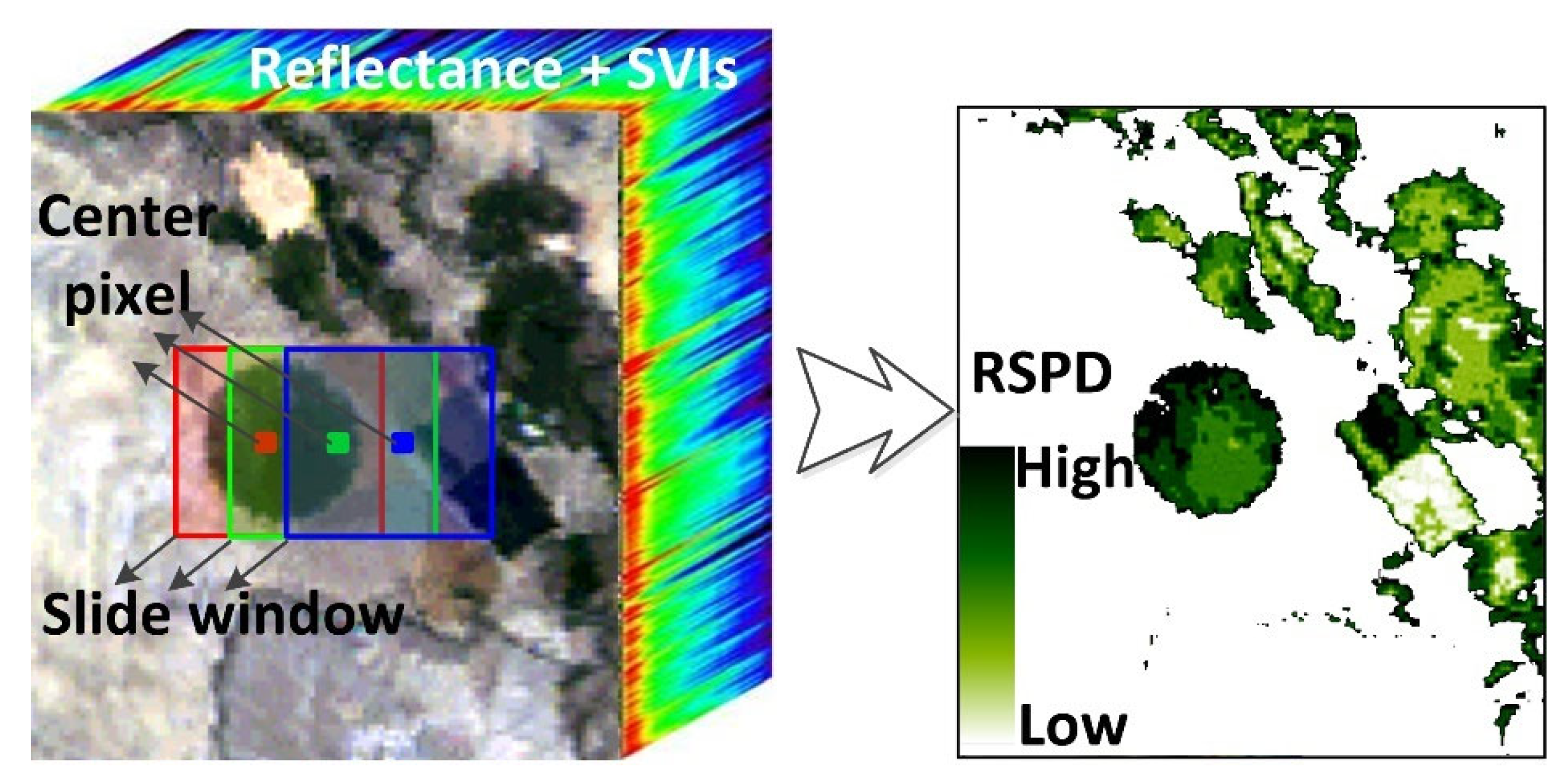
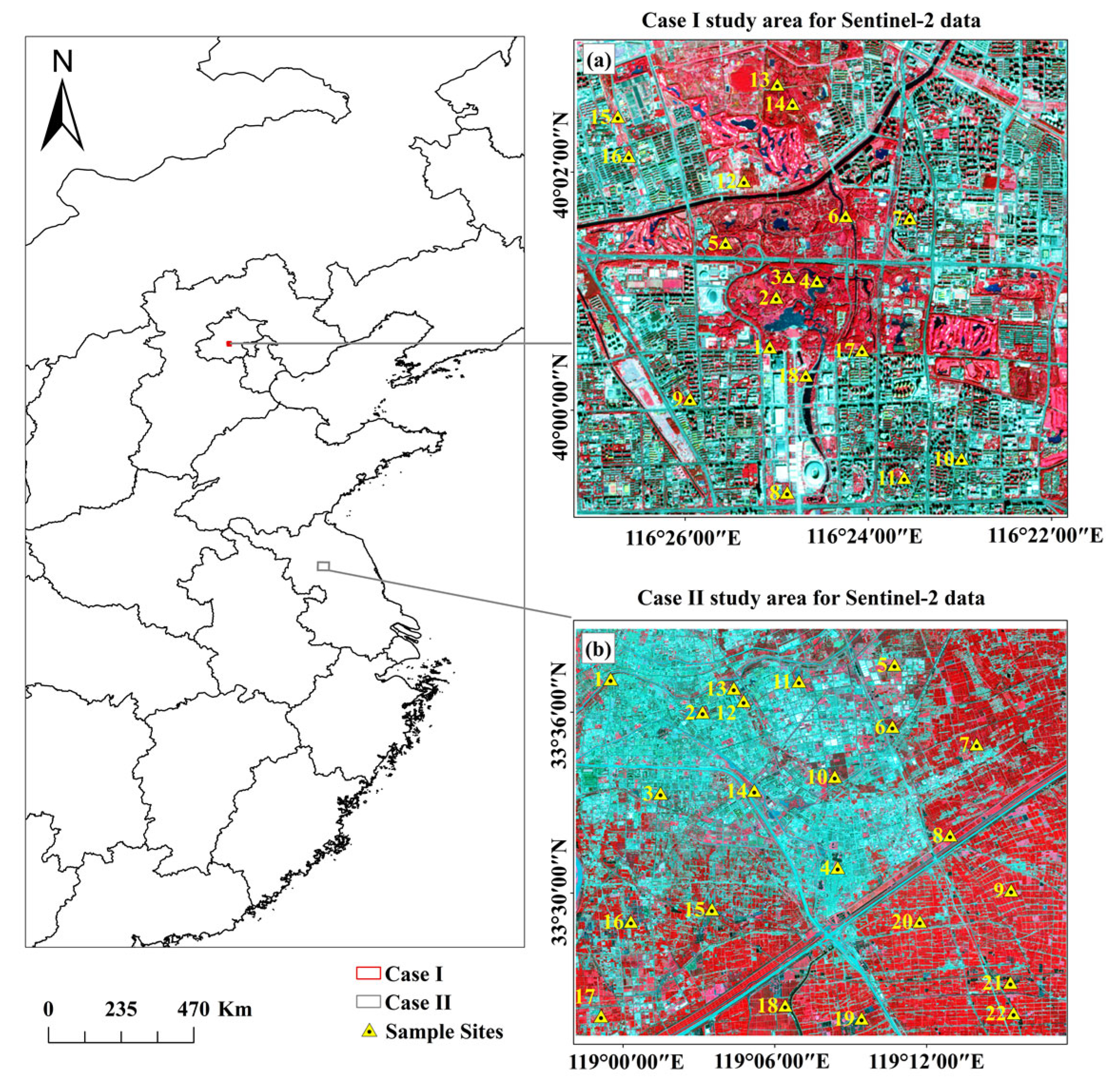


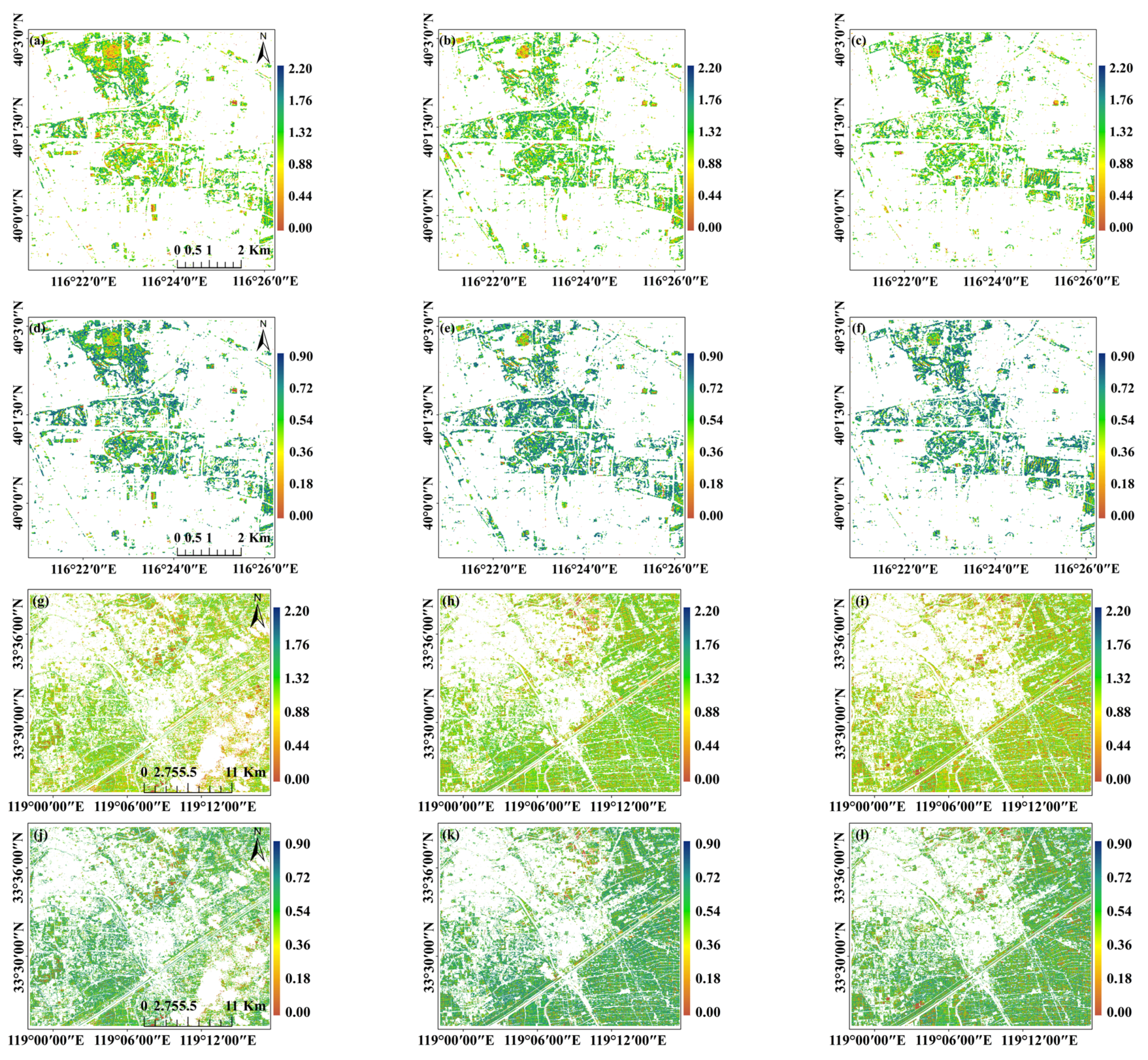


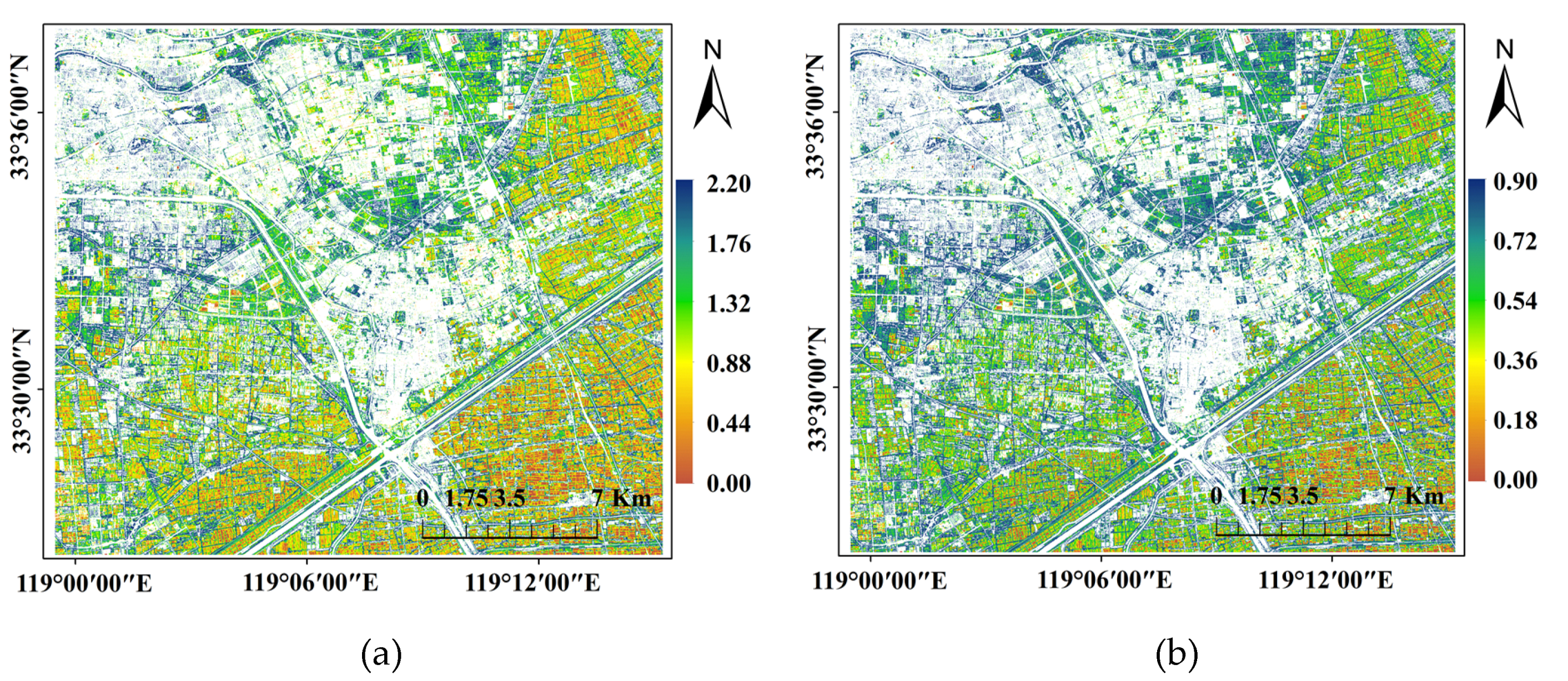


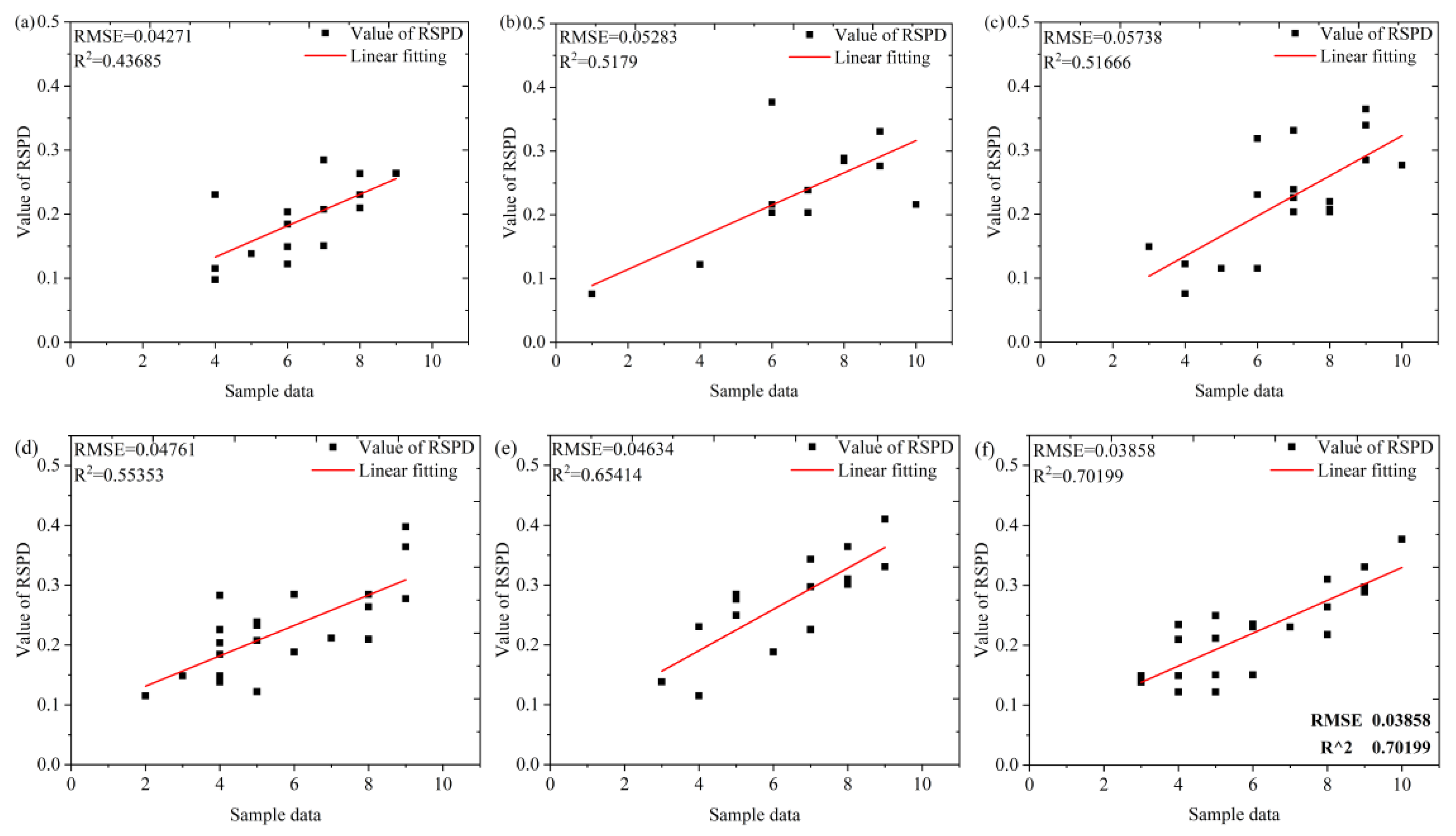

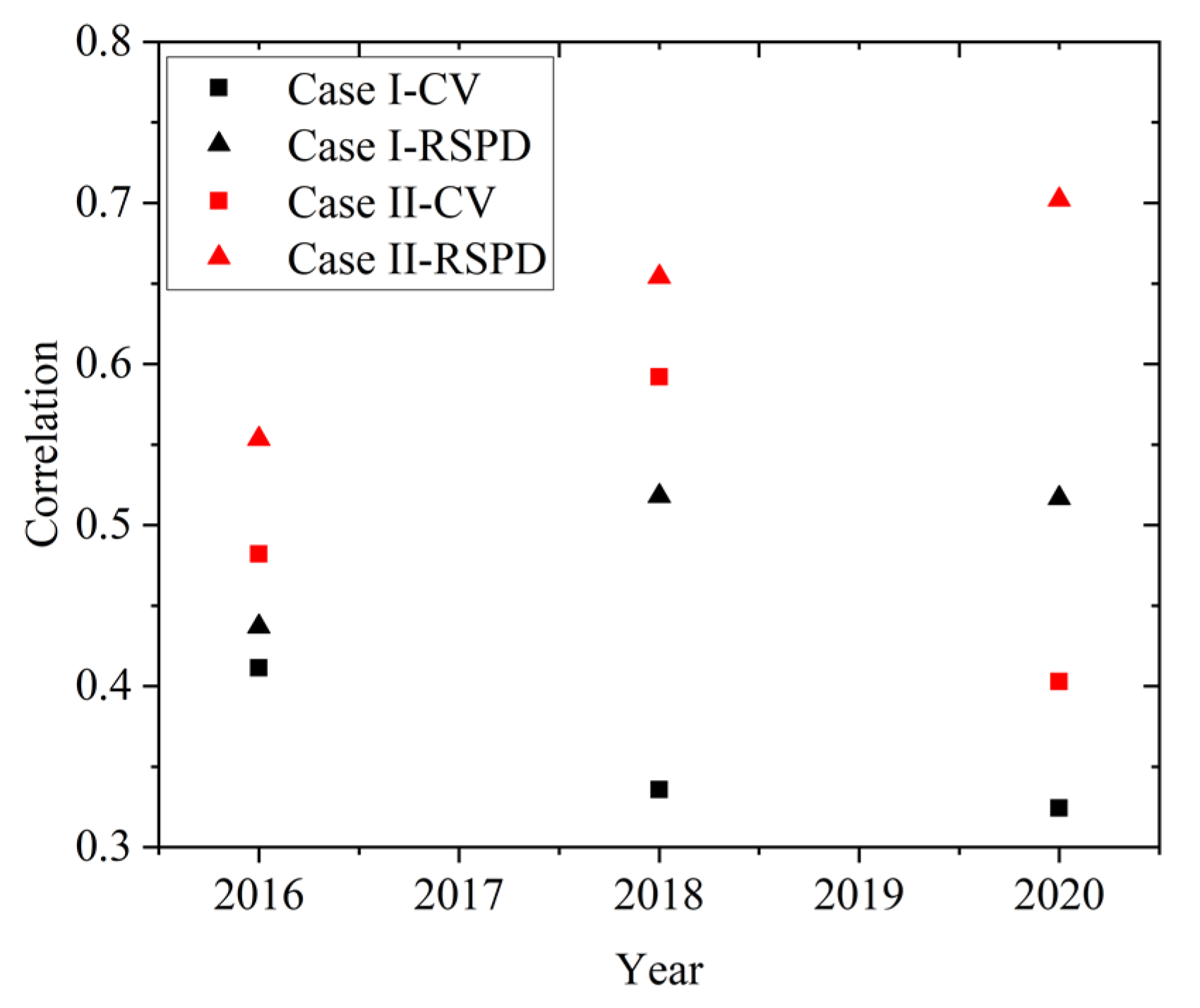
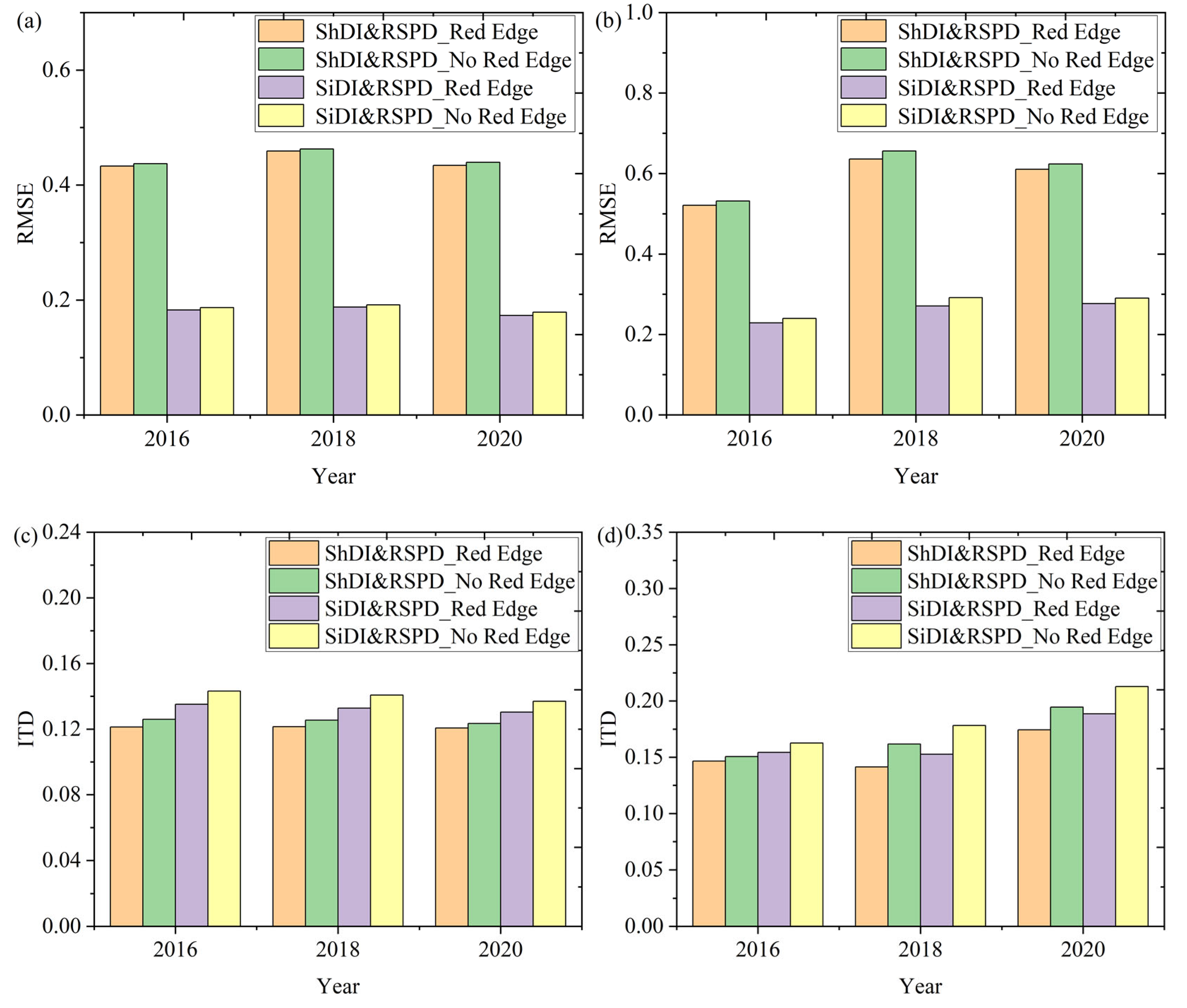
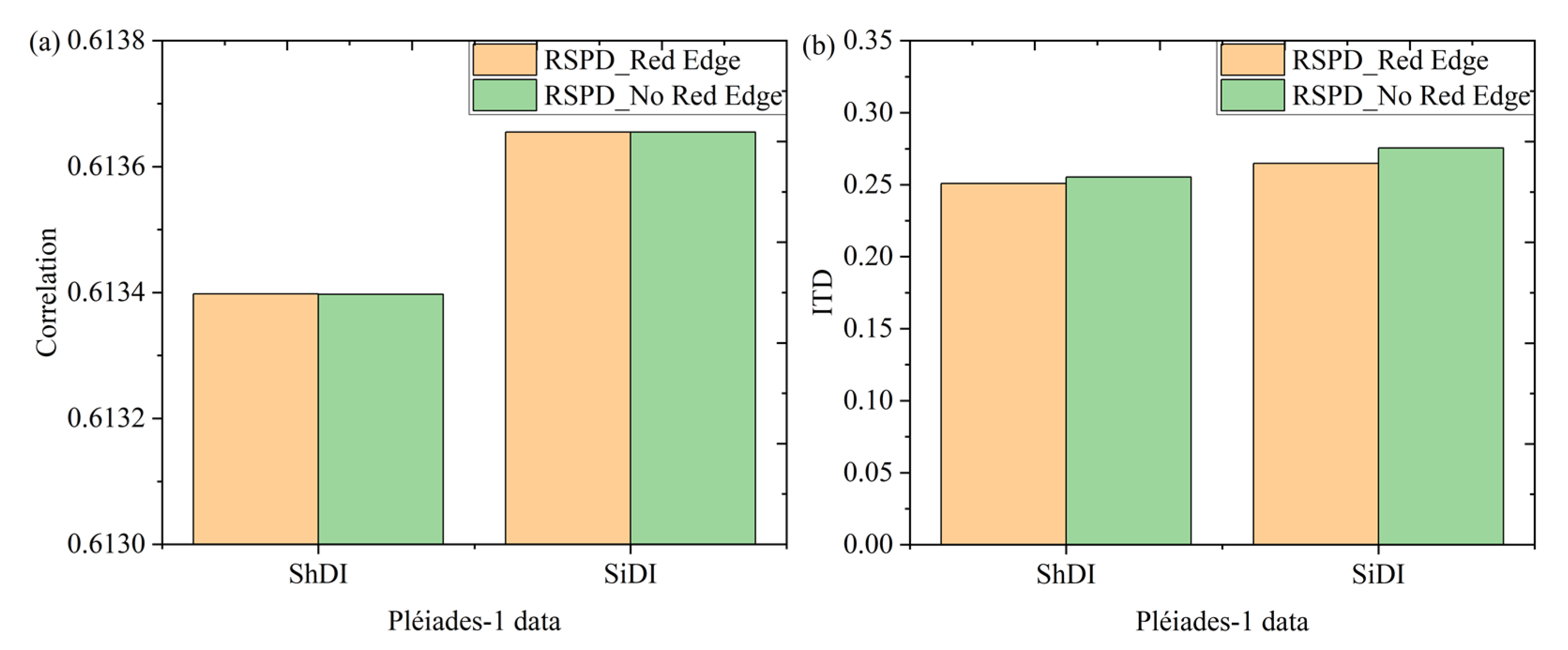
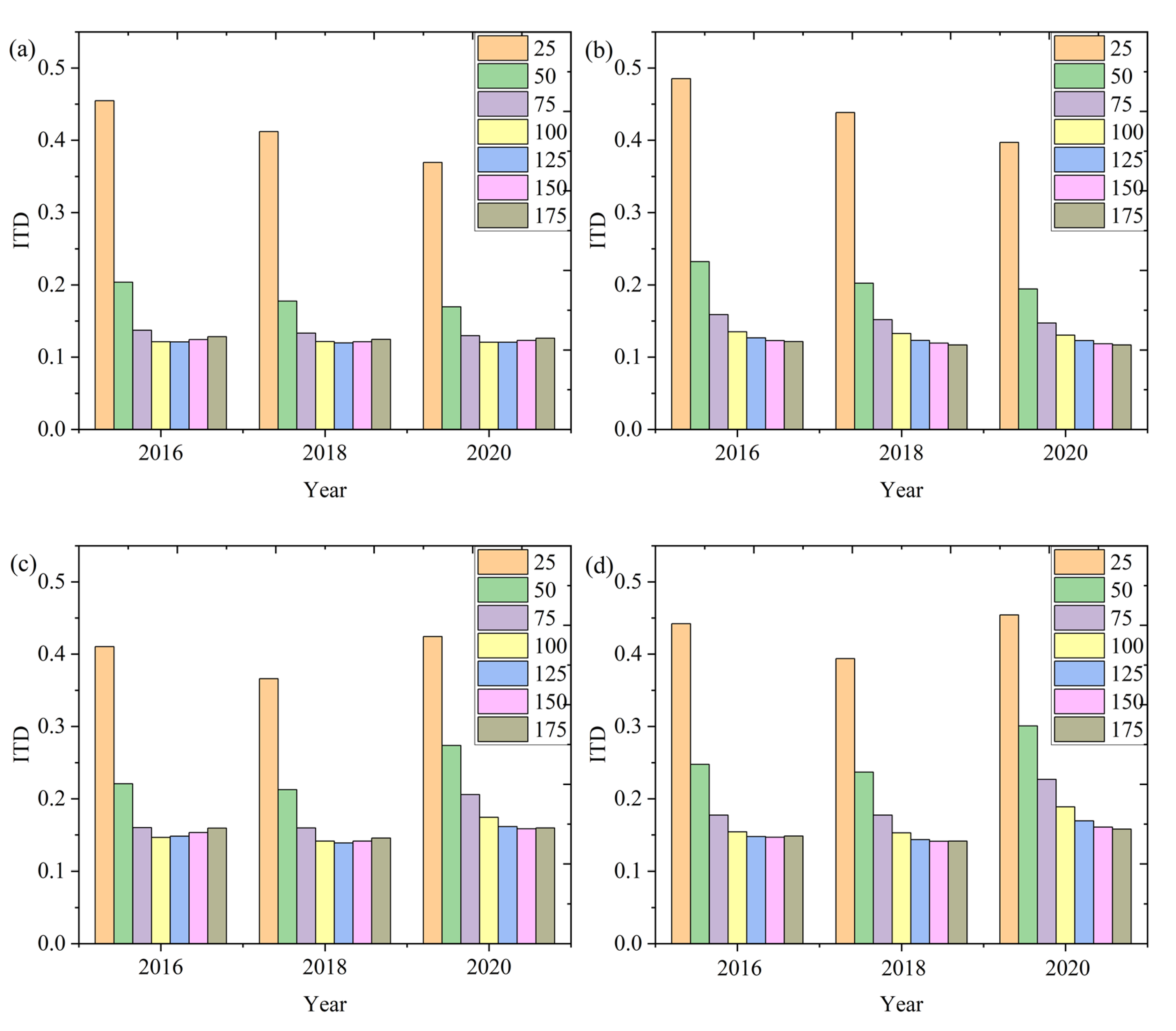
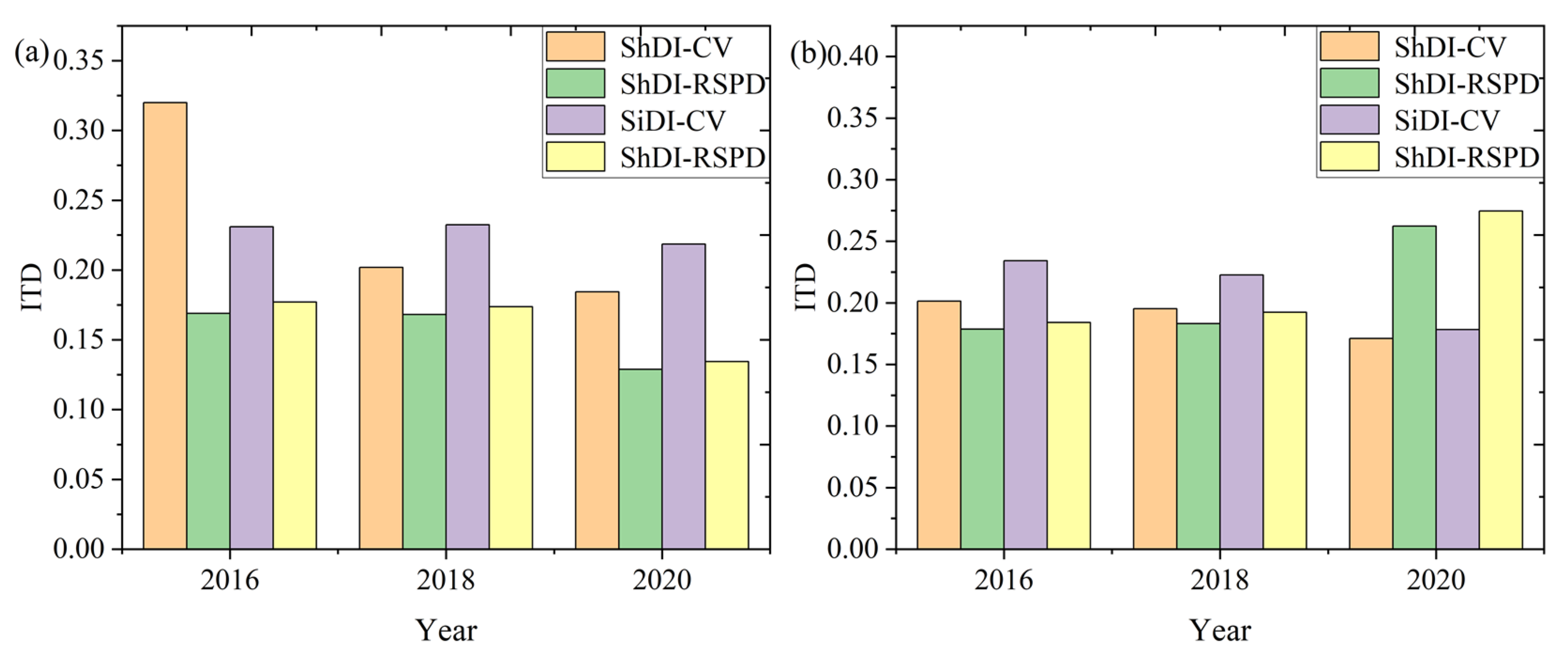
| Band Number | S2A | S2B | Spatial Resolution (m) | ||
|---|---|---|---|---|---|
| Central Wavelength (nm) | Bandwidth (nm) | Central Wavelength (nm) | Bandwidth (nm) | ||
| 1 | 443.9 | 27 | 442.3 | 45 | 60 |
| 2 | 496.6 | 98 | 492.1 | 98 | 10 |
| 3 | 560 | 45 | 559 | 46 | 10 |
| 4 | 664.5 | 38 | 665 | 39 | 10 |
| 5 | 703.9 | 19 | 703.8 | 20 | 20 |
| 6 | 740.2 | 18 | 739.1 | 18 | 20 |
| 7 | 782.5 | 28 | 779.7 | 28 | 20 |
| 8 | 835.1 | 145 | 833 | 133 | 10 |
| 8a | 864.8 | 33 | 864 | 32 | 20 |
| 9 | 945 | 26 | 943.2 | 27 | 60 |
| 10 | 1373.5 | 75 | 1376.9 | 76 | 60 |
| 11 | 1613.7 | 143 | 1610.4 | 141 | 20 |
| 12 | 2202.4 | 242 | 2185.7 | 238 | 20 |
| Case I | Min | Max | Mean | |||
|---|---|---|---|---|---|---|
| RSPD | CV | RSPD | CV | RSPD | CV | |
| 2016 | 0 | 0.001358 | 0.443673 | 0.285537 | 0.215822 | 0.061429 |
| 2018 | 0 | 0.001528 | 0.477121 | 0.493477 | 0.237009 | 0.086106 |
| 2020 | 0 | 0.003064 | 0.477121 | 0.504260 | 0.253524 | 0.096511 |
| Case II | Min | Max | Mean | |||
|---|---|---|---|---|---|---|
| RSPD | CV | RSPD | CV | RSPD | CV | |
| 2016 | 0 | 0.002980 | 0.477121 | 0.686903 | 0.210889 | 0.083789 |
| 2018 | 0 | 0.001722 | 0.477121 | 0.481739 | 0.219088 | 0.092678 |
| 2020 | 0 | 0.004737 | 0.477121 | 0.449763 | 0.183124 | 0.078497 |
| Sample Sites | Case I | Case II | ||||
|---|---|---|---|---|---|---|
| 2016 | 2018 | 2020 | 2016 | 2018 | 2020 | |
| 1 | 9 | 10 | 10 | 5 | // | 5 |
| 2 | 8 | 4 | 7 | 4 | // | 4 |
| 3 | 8 | 8 | 9 | 6 | // | 6 |
| 4 | 7 | 8 | 8 | 5 | // | 5 |
| 5 | // | 6 | 4 | 8 | 8 | 8 |
| 6 | // | 4 | 4 | 8 | 8 | 8 |
| 7 | 6 | 8 | 8 | 7 | 8 | 7 |
| 8 | 4 | 7 | 5 | 9 | 9 | 10 |
| 9 | 6 | 6 | 7 | 3 | 5 | 4 |
| 10 | 5 | // | 7 | 4 | // | 3 |
| 11 | 7 | 7 | 9 | 4 | // | 4 |
| 12 | 7 | 9 | 9 | 5 | // | 5 |
| 13 | 4 | // | 6 | 9 | 9 | 8 |
| 14 | 6 | // | 6 | 4 | 5 | 3 |
| 15 | 4 | 1 | 3 | 8 | 7 | 9 |
| 16 | // | // | 7 | 5 | 7 | 6 |
| 17 | 8 | 9 | 8 | 6 | 4 | 6 |
| 18 | 6 | 6 | 6 | 2 | 3 | 3 |
| 19 | // | // | // | 8 | 7 | 9 |
| 20 | // | // | // | 4 | 5 | 5 |
| 21 | // | // | // | 4 | 4 | 4 |
| 22 | // | // | // | 9 | 6 | 9 |
Publisher’s Note: MDPI stays neutral with regard to jurisdictional claims in published maps and institutional affiliations. |
© 2021 by the authors. Licensee MDPI, Basel, Switzerland. This article is an open access article distributed under the terms and conditions of the Creative Commons Attribution (CC BY) license (https://creativecommons.org/licenses/by/4.0/).
Share and Cite
Sun, H.; Hu, J.; Wang, J.; Zhou, J.; Lv, L.; Nie, J. RSPD: A Novel Remote Sensing Index of Plant Biodiversity Combining Spectral Variation Hypothesis and Productivity Hypothesis. Remote Sens. 2021, 13, 3007. https://doi.org/10.3390/rs13153007
Sun H, Hu J, Wang J, Zhou J, Lv L, Nie J. RSPD: A Novel Remote Sensing Index of Plant Biodiversity Combining Spectral Variation Hypothesis and Productivity Hypothesis. Remote Sensing. 2021; 13(15):3007. https://doi.org/10.3390/rs13153007
Chicago/Turabian StyleSun, Hao, Jiaqi Hu, Jiaxiang Wang, Jingheng Zhou, Ling Lv, and Jingyan Nie. 2021. "RSPD: A Novel Remote Sensing Index of Plant Biodiversity Combining Spectral Variation Hypothesis and Productivity Hypothesis" Remote Sensing 13, no. 15: 3007. https://doi.org/10.3390/rs13153007
APA StyleSun, H., Hu, J., Wang, J., Zhou, J., Lv, L., & Nie, J. (2021). RSPD: A Novel Remote Sensing Index of Plant Biodiversity Combining Spectral Variation Hypothesis and Productivity Hypothesis. Remote Sensing, 13(15), 3007. https://doi.org/10.3390/rs13153007








